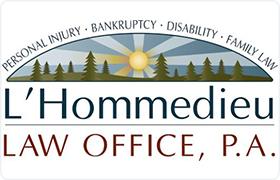 Gardiner Workout Lawyers, Maine
Gardiner Workout Lawyers, Maine
Sponsored Law Firm
-
 x
x

Click For More Info:
-
L'Hommedieu Law Office, P.A.
190 Bates Street Lewiston, ME 04240» view mapBankruptcy & Debt More Than Just A Law Firm
L'Hommedieu Law Office, P.A. has been providing the best in legal representation in Bankruptcy, Personal Injury, Disability and Family law since 1997.
800-941-5060
Warning! No lawyers found in this specified area.
Not enough matches for Gardiner Workout lawyer.
Below are all Gardiner Bankruptcy & Debt lawyers.
Lawyers
1-0 of 0 matches



 E. Chris L'Hommedieu Lewiston, ME
E. Chris L'Hommedieu Lewiston, ME Practice AreasExpertise
Practice AreasExpertise